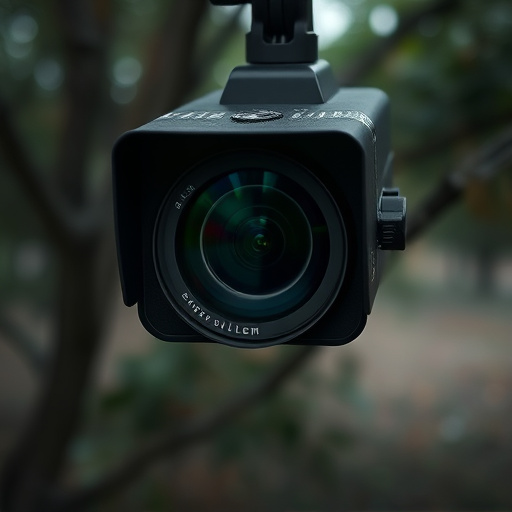RF (Radio Frequency) detector sweep technology is a cutting-edge method for identifying hidden cameras, particularly at front doors. This technique utilizes specialized equipment to detect and locate electromagnetic signals from covert surveillance devices like modern low-power radio frequency cameras. By sweeping across various frequencies, these detectors ensure enhanced security, peace of mind, and safety measures without disturbing potential hidden devices. A step-by-step guide using a high-quality RF detector teaches how to scan door areas, including the door, frame, walls, handles, locks, and mail slots. Proper calibration, regular maintenance, and understanding common RF signals are crucial for effective use. Starting with exterior handles and hinges, followed by indoor checks, helps identify suspicious findings that can be verified by security experts for appropriate countermeasures.
Uncover hidden threats with an RF detector sweep, a powerful tool in the fight against concealed cameras on front doors. This comprehensive guide delves into the technology behind RF detection, providing a step-by-step approach to identifying covert surveillance devices. From understanding radio frequency (RF) signals to practical tips for safe and effective use, we empower you with knowledge. Learn how to enhance your home security by detecting these invisible intruders, ensuring peace of mind for your family.
- Understanding RF Detector Sweep Technology for Hidden Cameras
- Detecting Concealed Cameras on Front Doors: A Step-by-Step Guide
- Essential Tips and Precautions When Using RF Detectors for Security
Understanding RF Detector Sweep Technology for Hidden Cameras
RF (Radio Frequency) detector sweep technology plays a pivotal role in detecting hidden cameras, particularly in high-risk areas like front doors. This advanced method utilizes specialized equipment to scan for electromagnetic signals emitted by covert surveillance devices. By sweeping across various frequencies, RF detectors can identify and pinpoint the location of Concealed Cameras for Front Door, ensuring your home or business remains secure.
The technology is non-invasive and operates without physically disturbing potential hidden devices. It’s an effective solution for detecting modern, high-tech cameras that often operate on low-power radio frequencies. This method allows security professionals to conduct thorough inspections, providing peace of mind and enhanced safety measures against unseen intruders or unwanted surveillance.
Detecting Concealed Cameras on Front Doors: A Step-by-Step Guide
Detecting concealed cameras on front doors has become an essential security measure for many homeowners, and it’s a skill worth learning. These tiny but powerful devices can be used to monitor your entranceways discreetly, providing peace of mind and an added layer of protection. Here’s a step-by-step guide to help you in this process:
1. Acquire the Right Tool: The first step is to invest in a high-quality RF (Radio Frequency) detector or sweep device. These tools are designed to detect signals from hidden cameras, often used in security cameras and surveillance equipment. Look for a device with adjustable sensitivity settings to accommodate various situations.
2. Inspect Your Doorway: Start by sweeping the area around your front door, including the door itself, door frame, and nearby walls. Move the detector slowly and methodically, ensuring you cover every inch of the surface. Pay particular attention to areas where a hidden camera might be installed, such as behind decorative elements or in voids between the door and frame.
3. Move Internally (if necessary): If you suspect a camera could be positioned internally, gently move objects like curtains, plants, or furniture that might obstruct your view. Take a close look at wall-mounted items, especially if they have any gaps or spaces behind them. Sometimes, cameras can be hidden in plain sight, so it’s crucial to check for any unusual markings or openings.
4. Check Common Hidden Spots: Concealed cameras often utilize creative hiding spots. Look for areas like door handles, locks, peepholes, and mail slots. These are common places where cameras can be discreetly mounted. Remember, a simple visual inspection might not always reveal the presence of these devices, so use your detector to double-check any potential locations.
5. Adjust Sensitivity (if available): Depending on the model, some RF detectors have adjustable sensitivity levels. If you suspect a very small or advanced camera, increasing the sensitivity can help pick up weaker signals. Test in an area with known cameras (or other electronic devices) to find the optimal setting.
Essential Tips and Precautions When Using RF Detectors for Security
When using RF detectors for security, especially in searching for concealed cameras on front doors, it’s crucial to follow essential tips and precautions. First, ensure your detector is properly calibrated and regularly maintained to avoid false readings. Different devices emit radio frequencies, so familiarize yourself with common RF signals from everyday items like remote controls and smartphones to minimize noise.
Second, be methodical in your sweep, covering every angle of the front door thoroughly. Start by scanning the exterior handles and hinges, as hidden cameras might be placed there. Then, move indoors and check for any unusual devices or modifications that could host RF signals. Always remain vigilant, keep notes, and if you suspect a potential concealed camera, consult with security professionals to confirm your findings and implement appropriate countermeasures.
RF detector sweeps offer a powerful tool for identifying concealed cameras on front doors, enhancing home security. By understanding the technology and following a simple step-by-step guide, you can effectively detect these hidden devices. Remember to employ essential tips and precautions when using RF detectors to ensure optimal results and maintain your privacy. For those concerned about front door surveillance, this method is a game-changer in securing your home from pesky hidden cameras.
